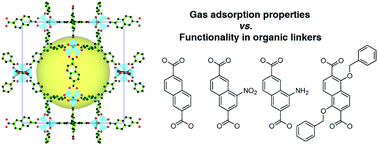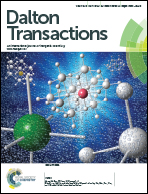Gas adsorption properties of highly porous metal–organic frameworks containing functionalized naphthalene dicarboxylate linkers†
Abstract
Three functionalized metal–organic frameworks (MOFs), MOF-205-NH2, MOF-205-NO2, and MOF-205-OBn, formulated as Zn4O(BTB)4/3(L), where BTB is benzene-1,3,5-tribenzoate and L is 1-aminonaphthalene-3,7-dicarboxylate (NDC-NH2), 1-nitronaphthalene-3,7-dicarboxylate (NDC-NO2) or 1,5-dibenzyloxy-2,6-naphthalenedicarboxylate (NDC-(OBn)2), were synthesized and their gas (H2, CO2, or CH4) adsorption properties were compared to those of the un-functionalized, parent MOF-205. Ordered structural models for MOF-205 and its derivatives were built based on the crystal structures and were subsequently used for predicting porosity properties. Although the Brunauer–Emmett–Teller (BET) surface areas of the three MOF-205 derivatives were reduced (MOF-205, 4460; MOF-205-NH2, 4330; MOF-205-NO2, 3980; MOF-205-OBn, 3470 m2 g−1), all three derivatives were shown to have enhanced H2 adsorption capacities at 77 K and CO2 uptakes at 253, 273, and 298 K respectively at 1 bar in comparison with MOF-205. The results indicate the following trend in H2 adsorption: MOF-205 < MOF-205-NO2 < MOF-205-NH2 < MOF-205-OBn. MOF-205-OBn showed good ideal adsorbed solution theory (IAST) selectivity values of 6.5 for CO2/N2 (15/85 in v/v) and 2.7 for CO2/CH4 (50/50 in v/v) at 298 K. Despite the large reduction (−22%) in the surface area, MOF-205-OBn displayed comparable total volumetric CO2 (at 48 bar) and CH4 (at 35 bar) storage capacities with those of MOF-205 at 298 K: MOF-205-OBn, 305 (CO2) and 112 (CH4) cm3 cm−3, and for MOF-205, 307 (CO2) and 120 (CH4) cm3 cm−3, respectively.


 Please wait while we load your content...
Please wait while we load your content...